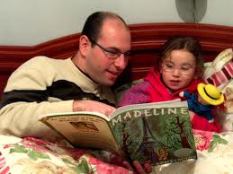 As a teacher, no child has ever told me that I was mean, to my face! Joking aside, what kids discuss at home is a different ball game. So, what should you do when your child dislikes his/her teacher? Here is some simple advice I got from the Parenting with Love and Logic website. Check out the whole article here.
As a teacher, no child has ever told me that I was mean, to my face! Joking aside, what kids discuss at home is a different ball game. So, what should you do when your child dislikes his/her teacher? Here is some simple advice I got from the Parenting with Love and Logic website. Check out the whole article here.
Tips:
1. Listen and empathize with your child if he/she complains about the teacher.- Typically when child says this, they really need a loving ear. Let them vent, don’t attempt to lecture, yell, or “fix” the problem.
2. Resist the urge to bash the teacher in front of your child.- Although you may not agree with the teacher, you should teacher your child that they should be respected and listened to. However, let your child know that inappropriate behaviors from any person is never acceptable. With so many child abuse allegations in the news, listening to your child and educating them about what appropriate behavior is, is critical.
3. Help your child understand that having a tough teacher isn’t a bad thing.- Help your child understand that having a tough teacher is an opportunity to be successful with the most difficult people. Same thing applies to the sports, watch “Miracle” if you haven’t already.
4. I loved this some much, I couldn’t paraphrase it:
“Remember: By teaching children to get along with a demanding teacher, we also are teaching them how to succeed with a demanding boss.
Research has shown employees get along with even the most demanding bosses when they:
- Get to work just a bit early every day
- Show up with a smile and a positive attitude
- Listen and follow directions
- Work a bit harder than expected
- Get along well with other employees and customers
Kids who learn these skills at home and at school succeed with the most difficult teachers, get better grades, and eventually rise to the top of their chosen occupation.” (Love and Logic Parenting resources)
5. Get involved only as a Last Resort– Fortunately totally incompetent and negative teachers are rare, but in some cases you may need to get involved. Even if your child is the most responsible and well-behaved student ever, some teachers just shouldn’t be in the profession and could make your child miserable. When you intervene, mind your manners and stay calm. If nothing comes of the situation, involve an administrator.
I also loved this bit, so I had to share it from the article:
“When we follow these tips, we give our kids the gift of knowing they can succeed around all different types of people. Unfortunately, some parents steal this wonderful opportunity by trying to make sure their children’s teachers are “perfect.” Sadly, as adults, many of these children spend their lives being unhappy because other people are “mean” or “unfair.”
Don’t fall into this trap! Use these Love and Logic tips, and give your kids the responsibility and self–confidence they deserve.”
Tags: add, adhd, bad habits, child dislikes teacher, children with special needs, courage, critical thinking, homework help, My teacher is mean, teacher, Teaching, tutoring, willow glen, willow glen tutoring





 ‘t, ask them about it. It’s a perfect opportunity to introduce new words.
‘t, ask them about it. It’s a perfect opportunity to introduce new words.
 Last year, a colleague shared a New YorkTimes article with me called,
Last year, a colleague shared a New YorkTimes article with me called, 
